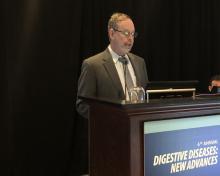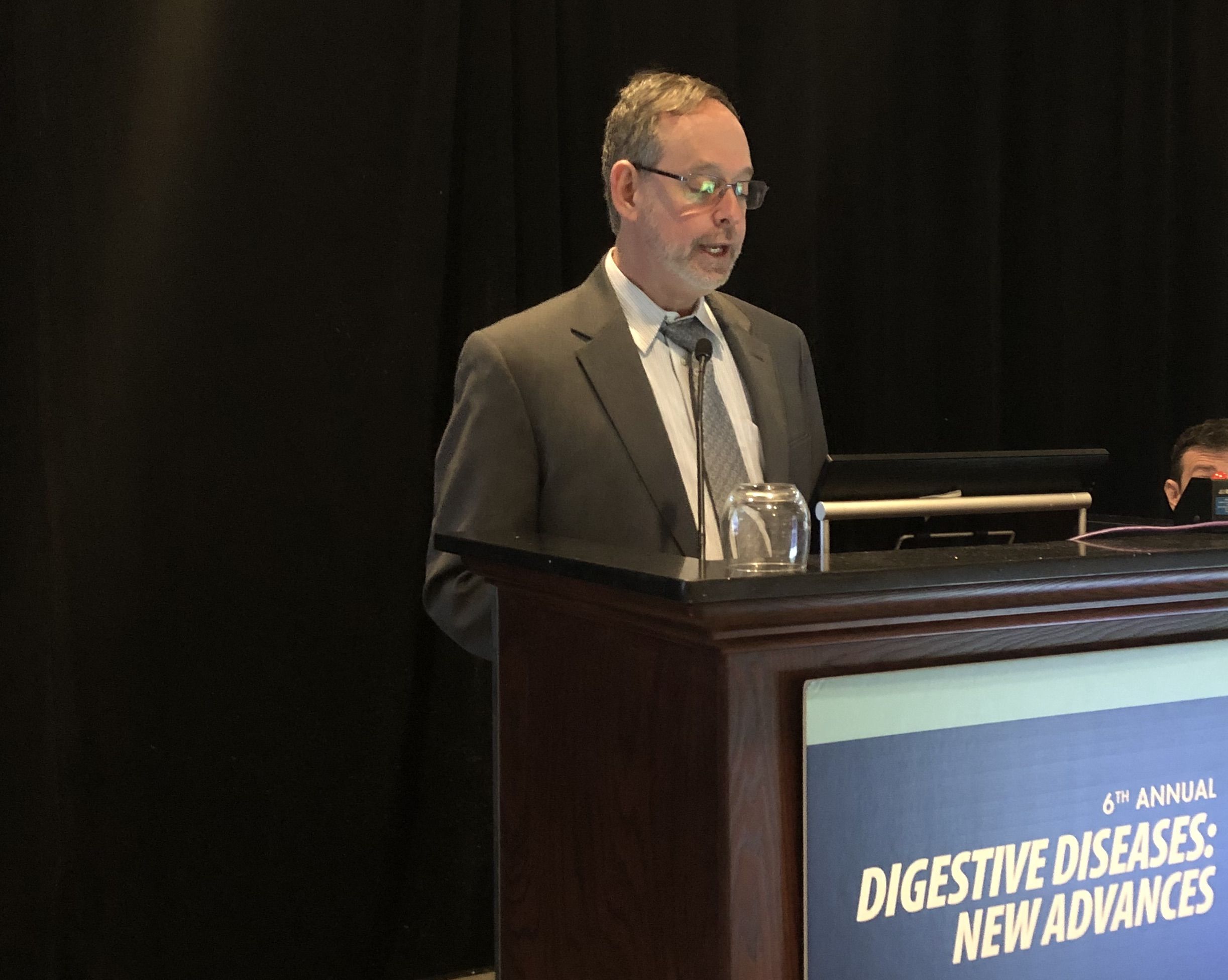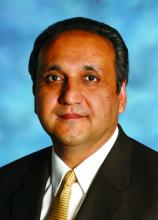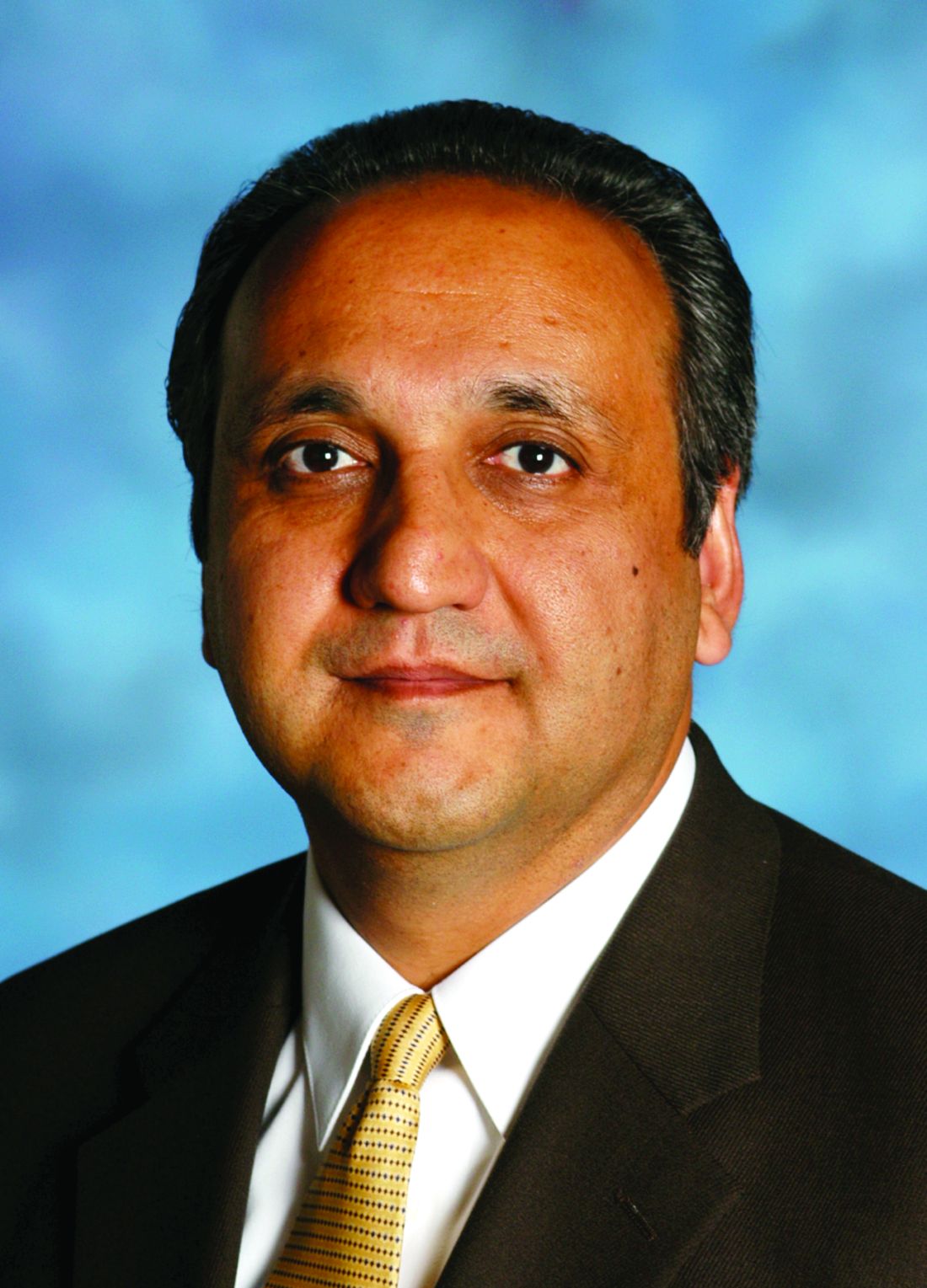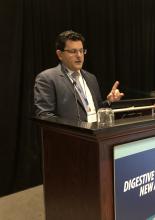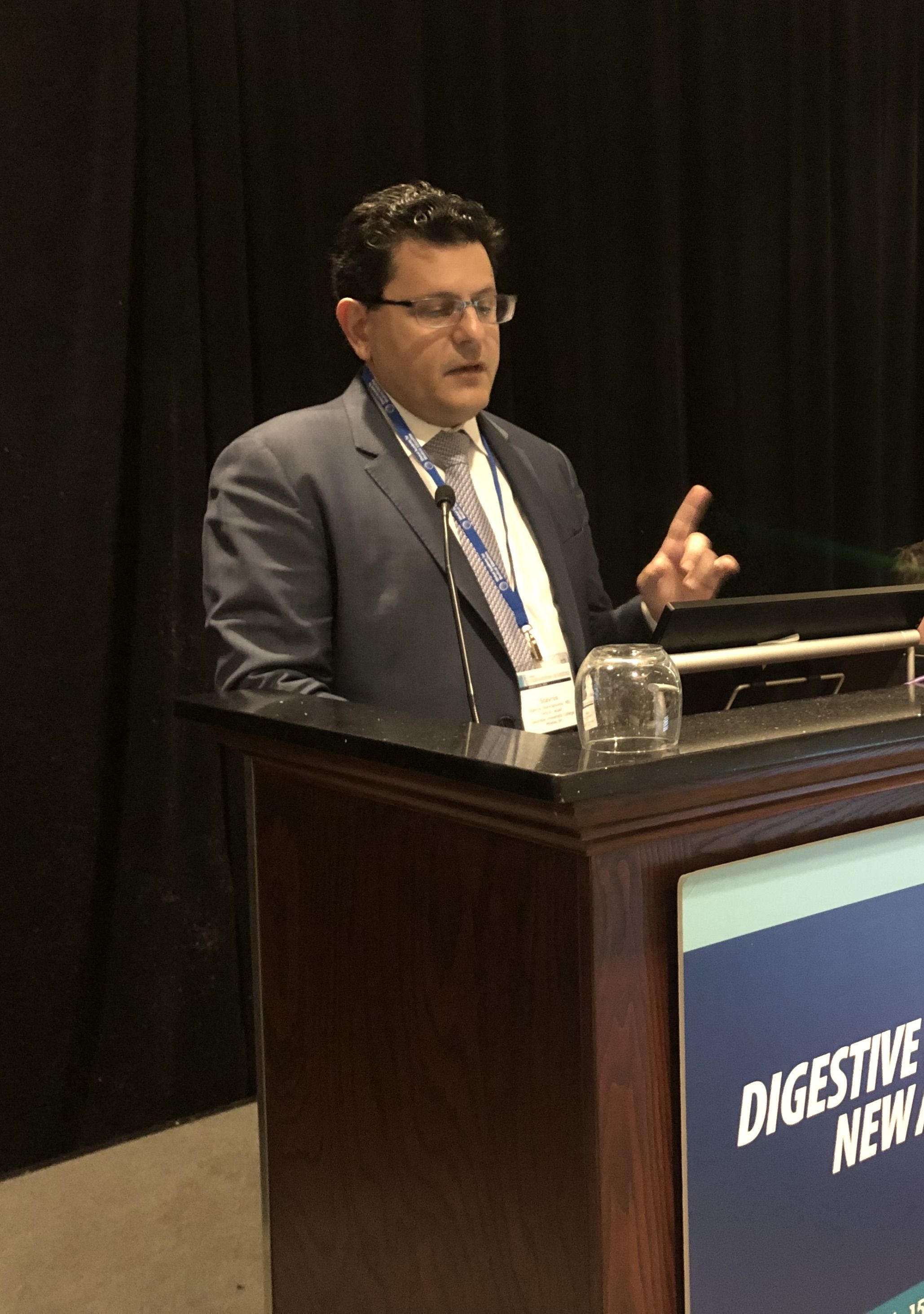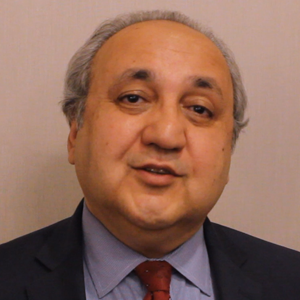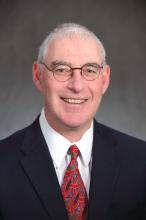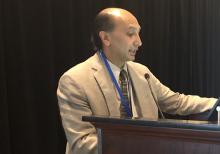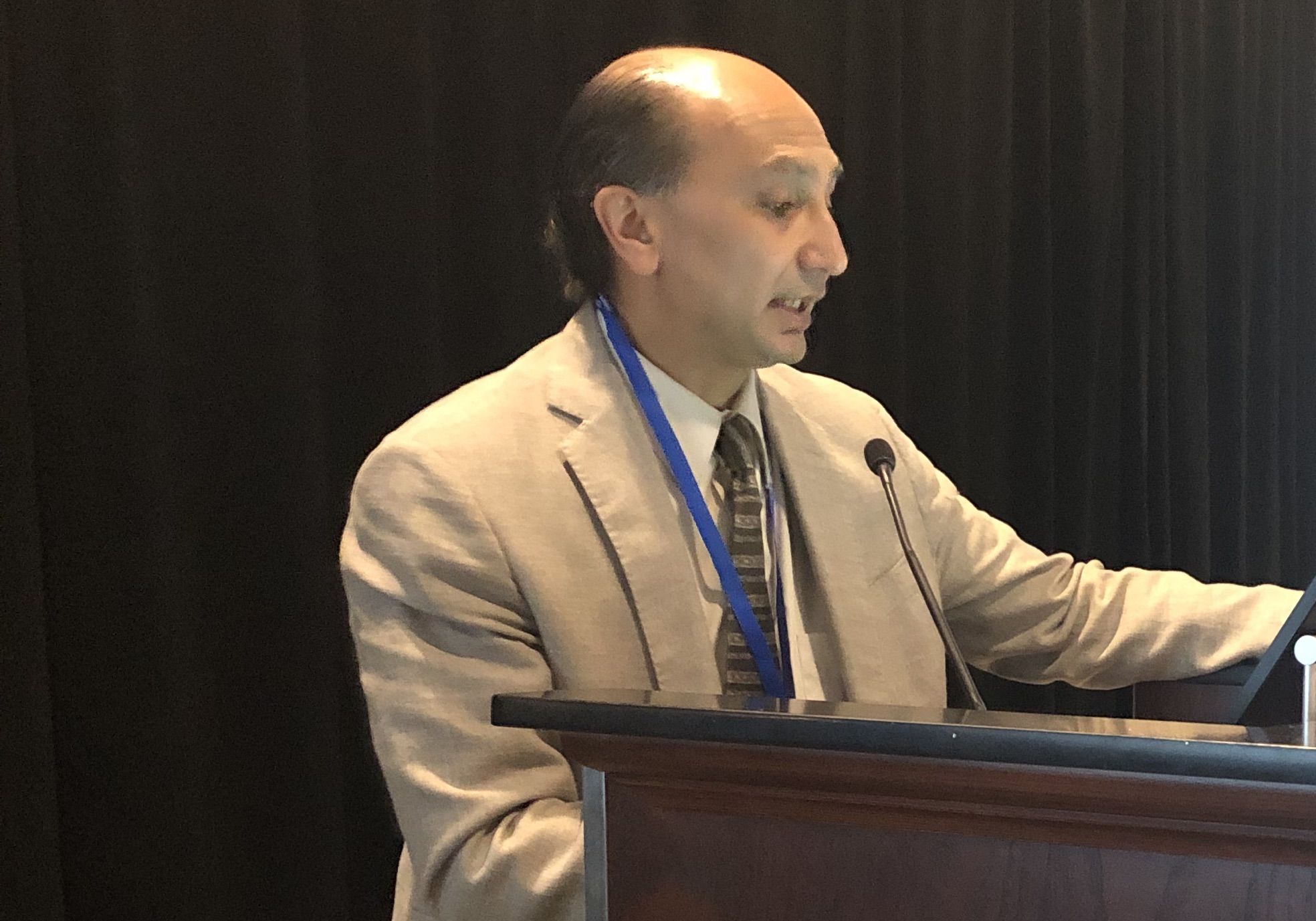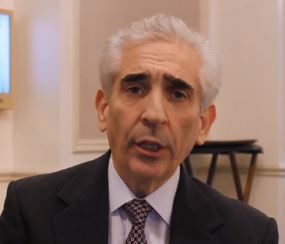User login
DDNA19: News and advances in IBD

Dr. Stephen Brant and Dr. Nikolaos Pyrsopoulos discuss the latest news and advances in inflammatory bowel disease (IBD) at Digestive Diseases: New Advances, jointly provided by Rutgers and Global Academy for Medical Education.
Global Academy and this news organization are owned by the same company.

Dr. Stephen Brant and Dr. Nikolaos Pyrsopoulos discuss the latest news and advances in inflammatory bowel disease (IBD) at Digestive Diseases: New Advances, jointly provided by Rutgers and Global Academy for Medical Education.
Global Academy and this news organization are owned by the same company.

Dr. Stephen Brant and Dr. Nikolaos Pyrsopoulos discuss the latest news and advances in inflammatory bowel disease (IBD) at Digestive Diseases: New Advances, jointly provided by Rutgers and Global Academy for Medical Education.
Global Academy and this news organization are owned by the same company.
REPORTING FROM DIGESTIVE DISEASES: NEW ADVANCES
DDNA19: The role of the microbiome in liver disease

Stephen Brant, MD, and Nikolaos Pyrsopoulos, MD, discuss the latest news and the role of the microbiome in liver diseases at Digestive Diseases: New Advances, jointly provided by Rutgers and Global Academy for Medical Education.
Global Academy and this news organization are owned by the same company.

Stephen Brant, MD, and Nikolaos Pyrsopoulos, MD, discuss the latest news and the role of the microbiome in liver diseases at Digestive Diseases: New Advances, jointly provided by Rutgers and Global Academy for Medical Education.
Global Academy and this news organization are owned by the same company.

Stephen Brant, MD, and Nikolaos Pyrsopoulos, MD, discuss the latest news and the role of the microbiome in liver diseases at Digestive Diseases: New Advances, jointly provided by Rutgers and Global Academy for Medical Education.
Global Academy and this news organization are owned by the same company.
REPORTING FROM DIGESTIVE DISEASES: NEW ADVANCES
Guidelines demur, but probiotics, curcumin may help in some UC patients
PHILADELPHIA – Although the new ulcerative colitis guidelines make no current recommendations on probiotics and curcumin because of gaps in knowledge, both may be beneficial today in selected patients, an expert said at the meeting jointly provided by Rutgers and Global Academy for Medical Education.
“Probiotics can be added, in my opinion, to patients on mesalamine with mild to moderate ulcerative colitis in order to help induce remission without having to go to immunosuppressive medication,” said Steven R. Brant, MD, chief of the division of gastroenterology and hepatology at Robert Wood Johnson Medical School, New Brunswick, N.J.
Likewise, curcumin has shown “minimal harm” in mild ulcerative colitis and may help nudge patients toward disease control without having to resort to corticosteroids or other immunosuppressive therapy, Dr. Brant said.
The new American Gastroenterological Association guidelines for treatment of mild to moderate ulcerative colitis, published in February in the journal Gastroenterology, declined to make recommendations on either probiotics or curcumin, citing “knowledge gaps and areas for future research.”
“Although these modalities appear to be safe, their use risks delaying proven effective therapy with the potential for worsening symptoms or complications,” Cynthia W. Ko, MD, and guideline coauthors said in the recommendations.
From the patient perspective, probiotics are “popular,” Dr. Brant said in his presentation, noting that some patients will request probiotics as a first-line therapy or even ask to be taken off mesalamine and put on probiotics.
Meta-analyses have provided differing conclusions on the benefits of probiotics. One recently published analysis of probiotics versus mesalamine showed a slight trend to favor mesalamine, but when looking at good-quality studies only, the meta-analysis showed a nonsignificant trend in favor of probiotics, Dr. Brant said.
By contrast, in a Cochrane meta-analysis of mesalamine at standard doses versus placebo, there was consistent evidence for a benefit of mesalamine: “so the main problem with giving probiotics as a choice is that you’re going to put the patient at risk for progressive symptoms and complications,” said Dr. Brant.
However, looking specifically at the probiotic VSL#3, the Toronto Ulcerative Colitis Consensus Group said that it was linked to significantly improved remission (44% vs. 25%; odds ratio, 2.4; P = .0007). Coverage issues could be a snag, since the amount of the probiotic associated with improved remission was equivalent to four double-strength packets. “Try getting that approved,” Dr. Brant told attendees. “You’ll have some challenges.”
Curcumin was evaluated in a multicenter trial showing that, when added to maximal mesalamine, it may be helpful in avoiding an advance in therapy, with 54% achieving clinical remission at week 4 versus 0% of placebo-treated patients.
That was a “reasonable study” but more research needs to be done, Dr. Brant said.
“I think that given the minimal harm, it may be worth a trial, though not in patients that are really having systemic symptoms, severe bleeding, and are getting worse,” he said. “It’s patients that have some response on mesalamine where it may be valuable, if you have time to spare to give them curcumin.”
Dr. Brant indicated that he had no relevant financial relationships to disclose.
Global Academy and this news organization are owned by the same parent company.
PHILADELPHIA – Although the new ulcerative colitis guidelines make no current recommendations on probiotics and curcumin because of gaps in knowledge, both may be beneficial today in selected patients, an expert said at the meeting jointly provided by Rutgers and Global Academy for Medical Education.
“Probiotics can be added, in my opinion, to patients on mesalamine with mild to moderate ulcerative colitis in order to help induce remission without having to go to immunosuppressive medication,” said Steven R. Brant, MD, chief of the division of gastroenterology and hepatology at Robert Wood Johnson Medical School, New Brunswick, N.J.
Likewise, curcumin has shown “minimal harm” in mild ulcerative colitis and may help nudge patients toward disease control without having to resort to corticosteroids or other immunosuppressive therapy, Dr. Brant said.
The new American Gastroenterological Association guidelines for treatment of mild to moderate ulcerative colitis, published in February in the journal Gastroenterology, declined to make recommendations on either probiotics or curcumin, citing “knowledge gaps and areas for future research.”
“Although these modalities appear to be safe, their use risks delaying proven effective therapy with the potential for worsening symptoms or complications,” Cynthia W. Ko, MD, and guideline coauthors said in the recommendations.
From the patient perspective, probiotics are “popular,” Dr. Brant said in his presentation, noting that some patients will request probiotics as a first-line therapy or even ask to be taken off mesalamine and put on probiotics.
Meta-analyses have provided differing conclusions on the benefits of probiotics. One recently published analysis of probiotics versus mesalamine showed a slight trend to favor mesalamine, but when looking at good-quality studies only, the meta-analysis showed a nonsignificant trend in favor of probiotics, Dr. Brant said.
By contrast, in a Cochrane meta-analysis of mesalamine at standard doses versus placebo, there was consistent evidence for a benefit of mesalamine: “so the main problem with giving probiotics as a choice is that you’re going to put the patient at risk for progressive symptoms and complications,” said Dr. Brant.
However, looking specifically at the probiotic VSL#3, the Toronto Ulcerative Colitis Consensus Group said that it was linked to significantly improved remission (44% vs. 25%; odds ratio, 2.4; P = .0007). Coverage issues could be a snag, since the amount of the probiotic associated with improved remission was equivalent to four double-strength packets. “Try getting that approved,” Dr. Brant told attendees. “You’ll have some challenges.”
Curcumin was evaluated in a multicenter trial showing that, when added to maximal mesalamine, it may be helpful in avoiding an advance in therapy, with 54% achieving clinical remission at week 4 versus 0% of placebo-treated patients.
That was a “reasonable study” but more research needs to be done, Dr. Brant said.
“I think that given the minimal harm, it may be worth a trial, though not in patients that are really having systemic symptoms, severe bleeding, and are getting worse,” he said. “It’s patients that have some response on mesalamine where it may be valuable, if you have time to spare to give them curcumin.”
Dr. Brant indicated that he had no relevant financial relationships to disclose.
Global Academy and this news organization are owned by the same parent company.
PHILADELPHIA – Although the new ulcerative colitis guidelines make no current recommendations on probiotics and curcumin because of gaps in knowledge, both may be beneficial today in selected patients, an expert said at the meeting jointly provided by Rutgers and Global Academy for Medical Education.
“Probiotics can be added, in my opinion, to patients on mesalamine with mild to moderate ulcerative colitis in order to help induce remission without having to go to immunosuppressive medication,” said Steven R. Brant, MD, chief of the division of gastroenterology and hepatology at Robert Wood Johnson Medical School, New Brunswick, N.J.
Likewise, curcumin has shown “minimal harm” in mild ulcerative colitis and may help nudge patients toward disease control without having to resort to corticosteroids or other immunosuppressive therapy, Dr. Brant said.
The new American Gastroenterological Association guidelines for treatment of mild to moderate ulcerative colitis, published in February in the journal Gastroenterology, declined to make recommendations on either probiotics or curcumin, citing “knowledge gaps and areas for future research.”
“Although these modalities appear to be safe, their use risks delaying proven effective therapy with the potential for worsening symptoms or complications,” Cynthia W. Ko, MD, and guideline coauthors said in the recommendations.
From the patient perspective, probiotics are “popular,” Dr. Brant said in his presentation, noting that some patients will request probiotics as a first-line therapy or even ask to be taken off mesalamine and put on probiotics.
Meta-analyses have provided differing conclusions on the benefits of probiotics. One recently published analysis of probiotics versus mesalamine showed a slight trend to favor mesalamine, but when looking at good-quality studies only, the meta-analysis showed a nonsignificant trend in favor of probiotics, Dr. Brant said.
By contrast, in a Cochrane meta-analysis of mesalamine at standard doses versus placebo, there was consistent evidence for a benefit of mesalamine: “so the main problem with giving probiotics as a choice is that you’re going to put the patient at risk for progressive symptoms and complications,” said Dr. Brant.
However, looking specifically at the probiotic VSL#3, the Toronto Ulcerative Colitis Consensus Group said that it was linked to significantly improved remission (44% vs. 25%; odds ratio, 2.4; P = .0007). Coverage issues could be a snag, since the amount of the probiotic associated with improved remission was equivalent to four double-strength packets. “Try getting that approved,” Dr. Brant told attendees. “You’ll have some challenges.”
Curcumin was evaluated in a multicenter trial showing that, when added to maximal mesalamine, it may be helpful in avoiding an advance in therapy, with 54% achieving clinical remission at week 4 versus 0% of placebo-treated patients.
That was a “reasonable study” but more research needs to be done, Dr. Brant said.
“I think that given the minimal harm, it may be worth a trial, though not in patients that are really having systemic symptoms, severe bleeding, and are getting worse,” he said. “It’s patients that have some response on mesalamine where it may be valuable, if you have time to spare to give them curcumin.”
Dr. Brant indicated that he had no relevant financial relationships to disclose.
Global Academy and this news organization are owned by the same parent company.
REPORTING FROM DIGESTIVE DISEASES: NEW ADVANCES
Future of NASH care means multiple targets, multiple providers, expert says
PHILADELPHIA – While current treatment options are limited for patients with nonalcoholic steatohepatitis (NASH), a number of potential agents in clinical trials, Zobair M. Younossi, MD, MPH, said here at the 6th annual Digestive Diseases: New Advances conference.
With agents currently available and those to come, the future will be focused on long-term management of NASH as a chronic disease in specialized centers, according to Dr. Younossi, chairman in the department of medicine at Inova Fairfax Hospital and vice president for research at Inova Health System, both in Falls Church, Va.
“We are not going to be able to cure NASH – we need to manage it,” Dr. Younossi said in a podium presentation. “NASH will be managed like type 2 diabetes. It’s not going to be treated like hepatitis C.”
Current treatment options are limited, with no Food and Drug Administration–approved options, and just two agents, vitamin E and pioglitazone, supported by guidance from the American Association for the Study of Liver Diseases (AASLD), Dr. Younossi said.
Public health interventions are needed to address the obesity and type 2 diabetes that are “the root of this disease,” Dr. Younossi said at the meeting, which was jointly provided by Rutgers and Global Academy for Medical Education.
Current AASLD guidance is based on studies suggesting that weight loss in the 3%-5% range may improve steatosis, and a 7%-10% weight loss can improve most histologic features of NASH, including fibrosis.
“The problem is that this is very hard to achieve,” Dr. Younossi said, adding that it is also hard to maintain. In a 2011 meta-analysis of clinical trials for reduction in nonalcoholic fatty liver disease, only a small minority of patients were able to maintain weight loss.
Bariatric surgery may be “very effective” for weight loss in the right patients, with some trials showing a proportion of patients maintaining improvement at 5-year follow-up, he said.
Exercise alone might prevent or reduce steatosis, but its effects on other aspects of liver histology, such as fibrosis, remain unknown, Dr. Younossi said.
Pioglitazone improves liver histology in patients with biopsy-proven NASH, although the benefits and risks, including potential adverse effects such as bone loss, diastolic dysfunction, or weight gain, should be discussed with each individual patient, he said.
Dr. Younossi highlighted randomized phase 3 trials for several agents that could figure into the treatment paradigm of NASH in the future by targeting different promoters of NASH and fibrosis progression. One of those was elafibranor, which targets the PPAR alpha/gamma pathways and is being evaluated versus placebo in NASH patients in the phase 3 RESOLVE-IT study. In a post hoc analysis of a previous randomized trial, the treatment resolved NASH without fibrosis worsening.
Other agents being evaluated in phase 3 trials include the CCR2/CCR5 receptor blocker cenicriviroc, the FXR agonist obeticholic acid, and the ASK-1 inhibitor selonsertib, Dr. Younossi said.
Optimal NASH care in the future may be based on targeting multiple such pathways, with patients increasingly treated at specialized centers that incorporate not only hepatologists, but also diabetes experts, dietitians, and exercise specialists.
“My own belief is that you have to treat this in the long term and also in a multidisciplinary sort of approach,” he said.
Dr. Younossi indicated that he is a consultant for Gilead, Intercept, Bristol-Myers Squibb, Novo Nordisk, Viking, Terms, Shionogi, AbbVie, Merck, and Novartis.
Global Academy and this news organization are owned by the same parent company.
PHILADELPHIA – While current treatment options are limited for patients with nonalcoholic steatohepatitis (NASH), a number of potential agents in clinical trials, Zobair M. Younossi, MD, MPH, said here at the 6th annual Digestive Diseases: New Advances conference.
With agents currently available and those to come, the future will be focused on long-term management of NASH as a chronic disease in specialized centers, according to Dr. Younossi, chairman in the department of medicine at Inova Fairfax Hospital and vice president for research at Inova Health System, both in Falls Church, Va.
“We are not going to be able to cure NASH – we need to manage it,” Dr. Younossi said in a podium presentation. “NASH will be managed like type 2 diabetes. It’s not going to be treated like hepatitis C.”
Current treatment options are limited, with no Food and Drug Administration–approved options, and just two agents, vitamin E and pioglitazone, supported by guidance from the American Association for the Study of Liver Diseases (AASLD), Dr. Younossi said.
Public health interventions are needed to address the obesity and type 2 diabetes that are “the root of this disease,” Dr. Younossi said at the meeting, which was jointly provided by Rutgers and Global Academy for Medical Education.
Current AASLD guidance is based on studies suggesting that weight loss in the 3%-5% range may improve steatosis, and a 7%-10% weight loss can improve most histologic features of NASH, including fibrosis.
“The problem is that this is very hard to achieve,” Dr. Younossi said, adding that it is also hard to maintain. In a 2011 meta-analysis of clinical trials for reduction in nonalcoholic fatty liver disease, only a small minority of patients were able to maintain weight loss.
Bariatric surgery may be “very effective” for weight loss in the right patients, with some trials showing a proportion of patients maintaining improvement at 5-year follow-up, he said.
Exercise alone might prevent or reduce steatosis, but its effects on other aspects of liver histology, such as fibrosis, remain unknown, Dr. Younossi said.
Pioglitazone improves liver histology in patients with biopsy-proven NASH, although the benefits and risks, including potential adverse effects such as bone loss, diastolic dysfunction, or weight gain, should be discussed with each individual patient, he said.
Dr. Younossi highlighted randomized phase 3 trials for several agents that could figure into the treatment paradigm of NASH in the future by targeting different promoters of NASH and fibrosis progression. One of those was elafibranor, which targets the PPAR alpha/gamma pathways and is being evaluated versus placebo in NASH patients in the phase 3 RESOLVE-IT study. In a post hoc analysis of a previous randomized trial, the treatment resolved NASH without fibrosis worsening.
Other agents being evaluated in phase 3 trials include the CCR2/CCR5 receptor blocker cenicriviroc, the FXR agonist obeticholic acid, and the ASK-1 inhibitor selonsertib, Dr. Younossi said.
Optimal NASH care in the future may be based on targeting multiple such pathways, with patients increasingly treated at specialized centers that incorporate not only hepatologists, but also diabetes experts, dietitians, and exercise specialists.
“My own belief is that you have to treat this in the long term and also in a multidisciplinary sort of approach,” he said.
Dr. Younossi indicated that he is a consultant for Gilead, Intercept, Bristol-Myers Squibb, Novo Nordisk, Viking, Terms, Shionogi, AbbVie, Merck, and Novartis.
Global Academy and this news organization are owned by the same parent company.
PHILADELPHIA – While current treatment options are limited for patients with nonalcoholic steatohepatitis (NASH), a number of potential agents in clinical trials, Zobair M. Younossi, MD, MPH, said here at the 6th annual Digestive Diseases: New Advances conference.
With agents currently available and those to come, the future will be focused on long-term management of NASH as a chronic disease in specialized centers, according to Dr. Younossi, chairman in the department of medicine at Inova Fairfax Hospital and vice president for research at Inova Health System, both in Falls Church, Va.
“We are not going to be able to cure NASH – we need to manage it,” Dr. Younossi said in a podium presentation. “NASH will be managed like type 2 diabetes. It’s not going to be treated like hepatitis C.”
Current treatment options are limited, with no Food and Drug Administration–approved options, and just two agents, vitamin E and pioglitazone, supported by guidance from the American Association for the Study of Liver Diseases (AASLD), Dr. Younossi said.
Public health interventions are needed to address the obesity and type 2 diabetes that are “the root of this disease,” Dr. Younossi said at the meeting, which was jointly provided by Rutgers and Global Academy for Medical Education.
Current AASLD guidance is based on studies suggesting that weight loss in the 3%-5% range may improve steatosis, and a 7%-10% weight loss can improve most histologic features of NASH, including fibrosis.
“The problem is that this is very hard to achieve,” Dr. Younossi said, adding that it is also hard to maintain. In a 2011 meta-analysis of clinical trials for reduction in nonalcoholic fatty liver disease, only a small minority of patients were able to maintain weight loss.
Bariatric surgery may be “very effective” for weight loss in the right patients, with some trials showing a proportion of patients maintaining improvement at 5-year follow-up, he said.
Exercise alone might prevent or reduce steatosis, but its effects on other aspects of liver histology, such as fibrosis, remain unknown, Dr. Younossi said.
Pioglitazone improves liver histology in patients with biopsy-proven NASH, although the benefits and risks, including potential adverse effects such as bone loss, diastolic dysfunction, or weight gain, should be discussed with each individual patient, he said.
Dr. Younossi highlighted randomized phase 3 trials for several agents that could figure into the treatment paradigm of NASH in the future by targeting different promoters of NASH and fibrosis progression. One of those was elafibranor, which targets the PPAR alpha/gamma pathways and is being evaluated versus placebo in NASH patients in the phase 3 RESOLVE-IT study. In a post hoc analysis of a previous randomized trial, the treatment resolved NASH without fibrosis worsening.
Other agents being evaluated in phase 3 trials include the CCR2/CCR5 receptor blocker cenicriviroc, the FXR agonist obeticholic acid, and the ASK-1 inhibitor selonsertib, Dr. Younossi said.
Optimal NASH care in the future may be based on targeting multiple such pathways, with patients increasingly treated at specialized centers that incorporate not only hepatologists, but also diabetes experts, dietitians, and exercise specialists.
“My own belief is that you have to treat this in the long term and also in a multidisciplinary sort of approach,” he said.
Dr. Younossi indicated that he is a consultant for Gilead, Intercept, Bristol-Myers Squibb, Novo Nordisk, Viking, Terms, Shionogi, AbbVie, Merck, and Novartis.
Global Academy and this news organization are owned by the same parent company.
EXPERT ANALYSIS FROM DIGESTIVE DISEASES: NEW ADVANCES
POEM outcomes ‘outstanding’ in achalasia with long-term follow-up
PHILADELPHIA – , Stavros N. Stavropoulos, MD, said at a meeting jointly provided by Rutgers and Global Academy for Medical Education.
“POEM represents a first-line treatment option for achalasia that has equivalent or superior efficacy to Heller [myotomy],” said Dr. Stavropoulos, MD, director of the program in advanced GI endoscopy at NYU Winthrop Hospital, Mineola, N.Y.
Although POEM is associated with more gastrointestinal reflux disease (GERD) than laparoscopic Heller myotomy, there is some evidence that the advantage of Heller in this respect may decrease over time, he told attendees.
“GERD after POEM is easily treatable with proton pump inhibitors (PPIs), with good patient satisfaction and no significant long-term GERD complications,” Dr. Stavropoulos said in a presentation on minimally invasive approaches to esophageal disorders.
NYU Winthrop Hospital was the site of the first human POEM outside of Japan, performed in 2009 by Dr. Stavropoulos, who along with colleagues recently published what he said is the largest single-operator POEM series in the Western hemisphere.
That report in Gastrointestinal Endoscopy (2018 Apr;87[4]:972-85) was based on 318 consecutive POEMs performed through October 2016. Dr. Stavropoulos and colleagues reported that over a median follow-up of 28 months they had a 95.7% clinical success rate, defined as a Eckardt score of 3 or more and no further treatment needed.
Those results suggested POEM should be a “treatment of choice” for challenging cases managed at centers who have a high level of experience with the procedure, the investigators said at the time.
Dr. Stavropoulos presented his center’s updated experience including 515 patients undergoing POEM, with a median follow-up of 37 months. About 50% of the patients were previously treated, including 73 (14% who underwent Heller myotomy).
Mean Eckardt scores were 7.7 preprocedure and 0.5 post procedure, while on timed barium swallow, emptying of 50% or greater at 5 minutes was seen in 96% of patients, and 100% emptying at 5 minutes was seen in 68%, according to data Dr. Stavropoulos presented.
Disease-free probability was 99% at 1 year and 90% at 5 years, he added.
There were no deaths, leaks, aborted procedures, or need for drains in this series, according to the investigator. Three percent of patients had a hospitalization exceeding 5 days, while 1% were readmitted because of minor adverse events related to POEM, such as dehydration, Dr. Stavropoulos reported.
In 2017, the American Gastroenterological Association published a clinical practice update “legitimizing” POEM as a first-line achalasia treatment, Dr. Stavropoulos said. That update said POEM should be performed in high-volume centers by experienced physicians.
Patients who experience GERD after POEM can be effectively treated with standard, once-daily PPI therapy, according to the expert.
“The absolute difference in GERD rates between laparoscopic Heller myotomy and POEM is 20%-25% at 1 year, but may decrease with time, and may be associated with inferior dysphagia relief in LHM patients,” Dr. Stavropoulos told attendees.
Dr. Stavropoulos disclosed that he is a consultant for Boston Scientific and ERBE.
Global Academy and this news organization are owned by the same company.
PHILADELPHIA – , Stavros N. Stavropoulos, MD, said at a meeting jointly provided by Rutgers and Global Academy for Medical Education.
“POEM represents a first-line treatment option for achalasia that has equivalent or superior efficacy to Heller [myotomy],” said Dr. Stavropoulos, MD, director of the program in advanced GI endoscopy at NYU Winthrop Hospital, Mineola, N.Y.
Although POEM is associated with more gastrointestinal reflux disease (GERD) than laparoscopic Heller myotomy, there is some evidence that the advantage of Heller in this respect may decrease over time, he told attendees.
“GERD after POEM is easily treatable with proton pump inhibitors (PPIs), with good patient satisfaction and no significant long-term GERD complications,” Dr. Stavropoulos said in a presentation on minimally invasive approaches to esophageal disorders.
NYU Winthrop Hospital was the site of the first human POEM outside of Japan, performed in 2009 by Dr. Stavropoulos, who along with colleagues recently published what he said is the largest single-operator POEM series in the Western hemisphere.
That report in Gastrointestinal Endoscopy (2018 Apr;87[4]:972-85) was based on 318 consecutive POEMs performed through October 2016. Dr. Stavropoulos and colleagues reported that over a median follow-up of 28 months they had a 95.7% clinical success rate, defined as a Eckardt score of 3 or more and no further treatment needed.
Those results suggested POEM should be a “treatment of choice” for challenging cases managed at centers who have a high level of experience with the procedure, the investigators said at the time.
Dr. Stavropoulos presented his center’s updated experience including 515 patients undergoing POEM, with a median follow-up of 37 months. About 50% of the patients were previously treated, including 73 (14% who underwent Heller myotomy).
Mean Eckardt scores were 7.7 preprocedure and 0.5 post procedure, while on timed barium swallow, emptying of 50% or greater at 5 minutes was seen in 96% of patients, and 100% emptying at 5 minutes was seen in 68%, according to data Dr. Stavropoulos presented.
Disease-free probability was 99% at 1 year and 90% at 5 years, he added.
There were no deaths, leaks, aborted procedures, or need for drains in this series, according to the investigator. Three percent of patients had a hospitalization exceeding 5 days, while 1% were readmitted because of minor adverse events related to POEM, such as dehydration, Dr. Stavropoulos reported.
In 2017, the American Gastroenterological Association published a clinical practice update “legitimizing” POEM as a first-line achalasia treatment, Dr. Stavropoulos said. That update said POEM should be performed in high-volume centers by experienced physicians.
Patients who experience GERD after POEM can be effectively treated with standard, once-daily PPI therapy, according to the expert.
“The absolute difference in GERD rates between laparoscopic Heller myotomy and POEM is 20%-25% at 1 year, but may decrease with time, and may be associated with inferior dysphagia relief in LHM patients,” Dr. Stavropoulos told attendees.
Dr. Stavropoulos disclosed that he is a consultant for Boston Scientific and ERBE.
Global Academy and this news organization are owned by the same company.
PHILADELPHIA – , Stavros N. Stavropoulos, MD, said at a meeting jointly provided by Rutgers and Global Academy for Medical Education.
“POEM represents a first-line treatment option for achalasia that has equivalent or superior efficacy to Heller [myotomy],” said Dr. Stavropoulos, MD, director of the program in advanced GI endoscopy at NYU Winthrop Hospital, Mineola, N.Y.
Although POEM is associated with more gastrointestinal reflux disease (GERD) than laparoscopic Heller myotomy, there is some evidence that the advantage of Heller in this respect may decrease over time, he told attendees.
“GERD after POEM is easily treatable with proton pump inhibitors (PPIs), with good patient satisfaction and no significant long-term GERD complications,” Dr. Stavropoulos said in a presentation on minimally invasive approaches to esophageal disorders.
NYU Winthrop Hospital was the site of the first human POEM outside of Japan, performed in 2009 by Dr. Stavropoulos, who along with colleagues recently published what he said is the largest single-operator POEM series in the Western hemisphere.
That report in Gastrointestinal Endoscopy (2018 Apr;87[4]:972-85) was based on 318 consecutive POEMs performed through October 2016. Dr. Stavropoulos and colleagues reported that over a median follow-up of 28 months they had a 95.7% clinical success rate, defined as a Eckardt score of 3 or more and no further treatment needed.
Those results suggested POEM should be a “treatment of choice” for challenging cases managed at centers who have a high level of experience with the procedure, the investigators said at the time.
Dr. Stavropoulos presented his center’s updated experience including 515 patients undergoing POEM, with a median follow-up of 37 months. About 50% of the patients were previously treated, including 73 (14% who underwent Heller myotomy).
Mean Eckardt scores were 7.7 preprocedure and 0.5 post procedure, while on timed barium swallow, emptying of 50% or greater at 5 minutes was seen in 96% of patients, and 100% emptying at 5 minutes was seen in 68%, according to data Dr. Stavropoulos presented.
Disease-free probability was 99% at 1 year and 90% at 5 years, he added.
There were no deaths, leaks, aborted procedures, or need for drains in this series, according to the investigator. Three percent of patients had a hospitalization exceeding 5 days, while 1% were readmitted because of minor adverse events related to POEM, such as dehydration, Dr. Stavropoulos reported.
In 2017, the American Gastroenterological Association published a clinical practice update “legitimizing” POEM as a first-line achalasia treatment, Dr. Stavropoulos said. That update said POEM should be performed in high-volume centers by experienced physicians.
Patients who experience GERD after POEM can be effectively treated with standard, once-daily PPI therapy, according to the expert.
“The absolute difference in GERD rates between laparoscopic Heller myotomy and POEM is 20%-25% at 1 year, but may decrease with time, and may be associated with inferior dysphagia relief in LHM patients,” Dr. Stavropoulos told attendees.
Dr. Stavropoulos disclosed that he is a consultant for Boston Scientific and ERBE.
Global Academy and this news organization are owned by the same company.
REPORTING FROM DIGESTIVE DISEASES: NEW ADVANCES
DDNA19: The NASH conundrum
Zobair Younossi, MD, MPH, chairman of the department of medicine at Inova Fairfax (Va.) Medical Campus, discusses the progressive form of NAFLD -- NASH -- and its optimal treatment.

Zobair Younossi, MD, MPH, chairman of the department of medicine at Inova Fairfax (Va.) Medical Campus, discusses the progressive form of NAFLD -- NASH -- and its optimal treatment.

Zobair Younossi, MD, MPH, chairman of the department of medicine at Inova Fairfax (Va.) Medical Campus, discusses the progressive form of NAFLD -- NASH -- and its optimal treatment.

AT DIGESTIVE DISEASES: NEW ADVANCES 2019
PPI-fracture link can’t be ruled out
PHILADELPHIA – While a potential effect can’t be ruled out, the evidence to date is inconsistent in terms of whether proton pump inhibitors increase risk of osteoporotic fractures, an expert said at the Digestive Diseases: New Advances conference jointly provided by Rutgers and Global Academy for Medical Education.
“These associations are possible,” said David C. Metz, MD, professor of medicine in the division of gastroenterology at the University of Pennsylvania, Philadelphia.
However, Dr. Metz cautioned attendees to “be cognizant of the limitations of epidemiological data,” and highlighted a recent randomized, double-blind trial he recently published with colleagues showing a lack of proton pump inhibitors (PPI) effect on bone homeostasis in healthy, postmenopausal women.
Taking all the evidence into consideration, Dr. Metz recommended judicious use of PPIs: “Don’t deny therapy because of concerns about long-term side effects. If the patient deserves the drug, they work. Use the lowest effective long-term maintenance dose, depending on the indication.”
Dr. Metz was senior author on a frequently cited 2006 report in JAMA linking long-term PPI therapy to increased hip fracture risk, particularly when given at high doses. That study “opened up a cottage industry” of researchers examining positive or negative associations with PPI therapy, he said.
In a 2016 meta-analysis including 18 studies, investigators reported in Osteoporosis International that PPIs “modestly increased” risk of hip fracture (relative risk, 1.26; 95% confidence interval, 1.16-1.36), along with similar risk increases for spine or any-site fracture. However, many of the studies incorporated into that analysis did not conclusively associate PPIs with fractures, according to Dr. Metz.
Moreover, there had been no randomized, prospective, double-blind trials on the subject published until this month, according to Dr. Metz, when he and his coauthors reported in Gastroenterology that dexlansoprazole and esomeprazole did not affect bone homeostasis in healthy, postmenopausal women. The randomized, 26-week study, mandated by the Food and Drug Administration to evaluate long-term PPI risks, was “essentially a negative study,” Dr. Metz said in his presentation.
“I think it gives us comfort in knowing to use the drug appropriately when indicated,” he said.
In the randomized study, there were no significant differences between the PPI and placebo groups in bone mineral density, parathyroid hormone levels, serum or urine levels of minerals, or calcium absorption. There were significant increases in markers of bone turnover in women receiving PPIs versus women receiving placebo, but the levels remained within the normal limits, according to the investigators.
Nevertheless, he said that clinicians do need to be mindful of a potential risk of fracture associated with PPIs, even if studies to date are inconclusive. “I don’t think that PPIs really have a biological explanation yet at this point as to why they may make your parents a little bit more fracturable, if you happen to be a postmenopausal female who’s at risk for that.”
Dr. Metz reported receiving grant/research support from AAA, Ipsen, Lexicon, and Wren Laboratories, consulting for Takeda, and serving as a board member for the North American Neuroendocrine Tumor Society. The study was funded by Takeda, which was responsible for and sponsored the study design, data collection, data interpretation, and writing of the manuscript appearing in Gastroenterology.
This news organization and Global Academy for Medical Education are owned by the same parent company.
PHILADELPHIA – While a potential effect can’t be ruled out, the evidence to date is inconsistent in terms of whether proton pump inhibitors increase risk of osteoporotic fractures, an expert said at the Digestive Diseases: New Advances conference jointly provided by Rutgers and Global Academy for Medical Education.
“These associations are possible,” said David C. Metz, MD, professor of medicine in the division of gastroenterology at the University of Pennsylvania, Philadelphia.
However, Dr. Metz cautioned attendees to “be cognizant of the limitations of epidemiological data,” and highlighted a recent randomized, double-blind trial he recently published with colleagues showing a lack of proton pump inhibitors (PPI) effect on bone homeostasis in healthy, postmenopausal women.
Taking all the evidence into consideration, Dr. Metz recommended judicious use of PPIs: “Don’t deny therapy because of concerns about long-term side effects. If the patient deserves the drug, they work. Use the lowest effective long-term maintenance dose, depending on the indication.”
Dr. Metz was senior author on a frequently cited 2006 report in JAMA linking long-term PPI therapy to increased hip fracture risk, particularly when given at high doses. That study “opened up a cottage industry” of researchers examining positive or negative associations with PPI therapy, he said.
In a 2016 meta-analysis including 18 studies, investigators reported in Osteoporosis International that PPIs “modestly increased” risk of hip fracture (relative risk, 1.26; 95% confidence interval, 1.16-1.36), along with similar risk increases for spine or any-site fracture. However, many of the studies incorporated into that analysis did not conclusively associate PPIs with fractures, according to Dr. Metz.
Moreover, there had been no randomized, prospective, double-blind trials on the subject published until this month, according to Dr. Metz, when he and his coauthors reported in Gastroenterology that dexlansoprazole and esomeprazole did not affect bone homeostasis in healthy, postmenopausal women. The randomized, 26-week study, mandated by the Food and Drug Administration to evaluate long-term PPI risks, was “essentially a negative study,” Dr. Metz said in his presentation.
“I think it gives us comfort in knowing to use the drug appropriately when indicated,” he said.
In the randomized study, there were no significant differences between the PPI and placebo groups in bone mineral density, parathyroid hormone levels, serum or urine levels of minerals, or calcium absorption. There were significant increases in markers of bone turnover in women receiving PPIs versus women receiving placebo, but the levels remained within the normal limits, according to the investigators.
Nevertheless, he said that clinicians do need to be mindful of a potential risk of fracture associated with PPIs, even if studies to date are inconclusive. “I don’t think that PPIs really have a biological explanation yet at this point as to why they may make your parents a little bit more fracturable, if you happen to be a postmenopausal female who’s at risk for that.”
Dr. Metz reported receiving grant/research support from AAA, Ipsen, Lexicon, and Wren Laboratories, consulting for Takeda, and serving as a board member for the North American Neuroendocrine Tumor Society. The study was funded by Takeda, which was responsible for and sponsored the study design, data collection, data interpretation, and writing of the manuscript appearing in Gastroenterology.
This news organization and Global Academy for Medical Education are owned by the same parent company.
PHILADELPHIA – While a potential effect can’t be ruled out, the evidence to date is inconsistent in terms of whether proton pump inhibitors increase risk of osteoporotic fractures, an expert said at the Digestive Diseases: New Advances conference jointly provided by Rutgers and Global Academy for Medical Education.
“These associations are possible,” said David C. Metz, MD, professor of medicine in the division of gastroenterology at the University of Pennsylvania, Philadelphia.
However, Dr. Metz cautioned attendees to “be cognizant of the limitations of epidemiological data,” and highlighted a recent randomized, double-blind trial he recently published with colleagues showing a lack of proton pump inhibitors (PPI) effect on bone homeostasis in healthy, postmenopausal women.
Taking all the evidence into consideration, Dr. Metz recommended judicious use of PPIs: “Don’t deny therapy because of concerns about long-term side effects. If the patient deserves the drug, they work. Use the lowest effective long-term maintenance dose, depending on the indication.”
Dr. Metz was senior author on a frequently cited 2006 report in JAMA linking long-term PPI therapy to increased hip fracture risk, particularly when given at high doses. That study “opened up a cottage industry” of researchers examining positive or negative associations with PPI therapy, he said.
In a 2016 meta-analysis including 18 studies, investigators reported in Osteoporosis International that PPIs “modestly increased” risk of hip fracture (relative risk, 1.26; 95% confidence interval, 1.16-1.36), along with similar risk increases for spine or any-site fracture. However, many of the studies incorporated into that analysis did not conclusively associate PPIs with fractures, according to Dr. Metz.
Moreover, there had been no randomized, prospective, double-blind trials on the subject published until this month, according to Dr. Metz, when he and his coauthors reported in Gastroenterology that dexlansoprazole and esomeprazole did not affect bone homeostasis in healthy, postmenopausal women. The randomized, 26-week study, mandated by the Food and Drug Administration to evaluate long-term PPI risks, was “essentially a negative study,” Dr. Metz said in his presentation.
“I think it gives us comfort in knowing to use the drug appropriately when indicated,” he said.
In the randomized study, there were no significant differences between the PPI and placebo groups in bone mineral density, parathyroid hormone levels, serum or urine levels of minerals, or calcium absorption. There were significant increases in markers of bone turnover in women receiving PPIs versus women receiving placebo, but the levels remained within the normal limits, according to the investigators.
Nevertheless, he said that clinicians do need to be mindful of a potential risk of fracture associated with PPIs, even if studies to date are inconclusive. “I don’t think that PPIs really have a biological explanation yet at this point as to why they may make your parents a little bit more fracturable, if you happen to be a postmenopausal female who’s at risk for that.”
Dr. Metz reported receiving grant/research support from AAA, Ipsen, Lexicon, and Wren Laboratories, consulting for Takeda, and serving as a board member for the North American Neuroendocrine Tumor Society. The study was funded by Takeda, which was responsible for and sponsored the study design, data collection, data interpretation, and writing of the manuscript appearing in Gastroenterology.
This news organization and Global Academy for Medical Education are owned by the same parent company.
EXPERT ANALYSIS FROM DIGESTIVE DISEASES: NEW ADVANCES
Will inpatient albumin help in decompensated cirrhosis?
PHILADELPHIA – , according to Vijay Shah, MD, chair of the division of gastroenterology and hepatology at Mayo Clinic, Rochester, Minn.
“These are interesting studies, but I don’t think we’re ready yet to use this broadly,” Dr. Shah said at the meeting jointly provided by Rutgers and Global Academy for Medical Education.
Current guidelines do describe the use of albumin for large-volume paracentesis and other specific inpatient situations; however, extrapolating its long-term use has been explored in two major studies that recently came out with contradictory findings.
In the ANSWER trial, as reported in the Lancet, investigators at 33 centers randomized patients with cirrhosis and uncomplicated ascites to either standard medical treatment with or without human albumin, at 40 g twice weekly for 2 weeks, followed by 40 g weekly for up to 18 months.
Those investigators found that long-term albumin prolonged overall survival, with a 38% reduction in the mortality hazard ratio, with similar rates of serious, nonliver adverse events, leading them to conclude that this intervention may act as a disease-modifying treatment in decompensated cirrhosis patients.
By contrast, however, a recent randomized, placebo-controlled trial reported in the Journal of Hepatology showed that albumin plus midodrine, an alpha-adrenergic vasoconstrictor, did not improve survival among patients with decompensated cirrhosis on the liver transplant waiting list, at least at the doses administered (midodrine 15-30 mg/day and albumin 40 g every 15 days for a year).
While this particular combination of albumin plus midodrine did decrease renin and aldosterone levels, the intervention did not prevent complications or improve survival, investigators said at the time. Complication rates were 37% and 43% for treatment and placebo, respectively (P = .402), with low rates of death in both groups and no significant difference in mortality at 1 year (P = .527).
Dr. Shah said the discrepant results may be attributable to specific differences in study design or enrollment.
“It’s just hand waving, but it may be related to the dose of albumin, or may be related to the types of patients – the second study was in patients who are waiting for liver transplantation,” he told attendees. “But I don’t think that there’s currently enough evidence to use albumin in your patients in the outpatient setting.”
There is a third study, recently published in the American Journal of Gastroenterology, looking at data for a large end-stage liver disease cohort with hyponatremia. Investigators observed a higher rate of hyponatremia resolution and improved 30-day survival in those who had received albumin (total mean amount, 225 g) versus those who had not.
Considering all of this evidence taken together, Dr. Shah said he would not favor using outpatient albumin at this point – though he advised attendees to watch for a currently recruiting phase 3 randomized study, known as PRECIOSA, which is evaluating long-term administration of human albumin 20% injectable solution, dosed by body weight, in patients with decompensated cirrhosis and ascites.
Dr. Shah indicated that he is a consultant for Afimmune, Durect Corporation, Enterome, GRI Bio, Merck Research Laboratories, Novartis Pharma, and Vital Therapeutics. Global Academy and this news organization are owned by the same company.
PHILADELPHIA – , according to Vijay Shah, MD, chair of the division of gastroenterology and hepatology at Mayo Clinic, Rochester, Minn.
“These are interesting studies, but I don’t think we’re ready yet to use this broadly,” Dr. Shah said at the meeting jointly provided by Rutgers and Global Academy for Medical Education.
Current guidelines do describe the use of albumin for large-volume paracentesis and other specific inpatient situations; however, extrapolating its long-term use has been explored in two major studies that recently came out with contradictory findings.
In the ANSWER trial, as reported in the Lancet, investigators at 33 centers randomized patients with cirrhosis and uncomplicated ascites to either standard medical treatment with or without human albumin, at 40 g twice weekly for 2 weeks, followed by 40 g weekly for up to 18 months.
Those investigators found that long-term albumin prolonged overall survival, with a 38% reduction in the mortality hazard ratio, with similar rates of serious, nonliver adverse events, leading them to conclude that this intervention may act as a disease-modifying treatment in decompensated cirrhosis patients.
By contrast, however, a recent randomized, placebo-controlled trial reported in the Journal of Hepatology showed that albumin plus midodrine, an alpha-adrenergic vasoconstrictor, did not improve survival among patients with decompensated cirrhosis on the liver transplant waiting list, at least at the doses administered (midodrine 15-30 mg/day and albumin 40 g every 15 days for a year).
While this particular combination of albumin plus midodrine did decrease renin and aldosterone levels, the intervention did not prevent complications or improve survival, investigators said at the time. Complication rates were 37% and 43% for treatment and placebo, respectively (P = .402), with low rates of death in both groups and no significant difference in mortality at 1 year (P = .527).
Dr. Shah said the discrepant results may be attributable to specific differences in study design or enrollment.
“It’s just hand waving, but it may be related to the dose of albumin, or may be related to the types of patients – the second study was in patients who are waiting for liver transplantation,” he told attendees. “But I don’t think that there’s currently enough evidence to use albumin in your patients in the outpatient setting.”
There is a third study, recently published in the American Journal of Gastroenterology, looking at data for a large end-stage liver disease cohort with hyponatremia. Investigators observed a higher rate of hyponatremia resolution and improved 30-day survival in those who had received albumin (total mean amount, 225 g) versus those who had not.
Considering all of this evidence taken together, Dr. Shah said he would not favor using outpatient albumin at this point – though he advised attendees to watch for a currently recruiting phase 3 randomized study, known as PRECIOSA, which is evaluating long-term administration of human albumin 20% injectable solution, dosed by body weight, in patients with decompensated cirrhosis and ascites.
Dr. Shah indicated that he is a consultant for Afimmune, Durect Corporation, Enterome, GRI Bio, Merck Research Laboratories, Novartis Pharma, and Vital Therapeutics. Global Academy and this news organization are owned by the same company.
PHILADELPHIA – , according to Vijay Shah, MD, chair of the division of gastroenterology and hepatology at Mayo Clinic, Rochester, Minn.
“These are interesting studies, but I don’t think we’re ready yet to use this broadly,” Dr. Shah said at the meeting jointly provided by Rutgers and Global Academy for Medical Education.
Current guidelines do describe the use of albumin for large-volume paracentesis and other specific inpatient situations; however, extrapolating its long-term use has been explored in two major studies that recently came out with contradictory findings.
In the ANSWER trial, as reported in the Lancet, investigators at 33 centers randomized patients with cirrhosis and uncomplicated ascites to either standard medical treatment with or without human albumin, at 40 g twice weekly for 2 weeks, followed by 40 g weekly for up to 18 months.
Those investigators found that long-term albumin prolonged overall survival, with a 38% reduction in the mortality hazard ratio, with similar rates of serious, nonliver adverse events, leading them to conclude that this intervention may act as a disease-modifying treatment in decompensated cirrhosis patients.
By contrast, however, a recent randomized, placebo-controlled trial reported in the Journal of Hepatology showed that albumin plus midodrine, an alpha-adrenergic vasoconstrictor, did not improve survival among patients with decompensated cirrhosis on the liver transplant waiting list, at least at the doses administered (midodrine 15-30 mg/day and albumin 40 g every 15 days for a year).
While this particular combination of albumin plus midodrine did decrease renin and aldosterone levels, the intervention did not prevent complications or improve survival, investigators said at the time. Complication rates were 37% and 43% for treatment and placebo, respectively (P = .402), with low rates of death in both groups and no significant difference in mortality at 1 year (P = .527).
Dr. Shah said the discrepant results may be attributable to specific differences in study design or enrollment.
“It’s just hand waving, but it may be related to the dose of albumin, or may be related to the types of patients – the second study was in patients who are waiting for liver transplantation,” he told attendees. “But I don’t think that there’s currently enough evidence to use albumin in your patients in the outpatient setting.”
There is a third study, recently published in the American Journal of Gastroenterology, looking at data for a large end-stage liver disease cohort with hyponatremia. Investigators observed a higher rate of hyponatremia resolution and improved 30-day survival in those who had received albumin (total mean amount, 225 g) versus those who had not.
Considering all of this evidence taken together, Dr. Shah said he would not favor using outpatient albumin at this point – though he advised attendees to watch for a currently recruiting phase 3 randomized study, known as PRECIOSA, which is evaluating long-term administration of human albumin 20% injectable solution, dosed by body weight, in patients with decompensated cirrhosis and ascites.
Dr. Shah indicated that he is a consultant for Afimmune, Durect Corporation, Enterome, GRI Bio, Merck Research Laboratories, Novartis Pharma, and Vital Therapeutics. Global Academy and this news organization are owned by the same company.
REPORTING FROM DIGESTIVE DISEASES: NEW ADVANCES
DDNA19: Cardiac Complications in Liver Disease Patients

Dr. Marc Klapholz of Rutgers University, Newark, N.J., explains the latest developments in portopulmonary arterial hypertension, hepatopulmonary syndrome, and cirrhotic cardiomyopathy, as well as the emerging field and association between non-alcoholic fatty liver disease and cardiovascular disease.

Dr. Marc Klapholz of Rutgers University, Newark, N.J., explains the latest developments in portopulmonary arterial hypertension, hepatopulmonary syndrome, and cirrhotic cardiomyopathy, as well as the emerging field and association between non-alcoholic fatty liver disease and cardiovascular disease.

Dr. Marc Klapholz of Rutgers University, Newark, N.J., explains the latest developments in portopulmonary arterial hypertension, hepatopulmonary syndrome, and cirrhotic cardiomyopathy, as well as the emerging field and association between non-alcoholic fatty liver disease and cardiovascular disease.
AT DIGESTIVE DISEASES: NEW ADVANCES
Dr. Julie Thompson Discusses Primary Biliary Cholangitis

At Digestive Diseases: New Advances (DDNA 2019), Dr. Julie A. Thompson of the University of Minnesota reviews key issues surrounding primary biliary cholangitis, including difficult symptoms to treat, an update on clinical trials, and patients that take medication and see no improvements.

At Digestive Diseases: New Advances (DDNA 2019), Dr. Julie A. Thompson of the University of Minnesota reviews key issues surrounding primary biliary cholangitis, including difficult symptoms to treat, an update on clinical trials, and patients that take medication and see no improvements.

At Digestive Diseases: New Advances (DDNA 2019), Dr. Julie A. Thompson of the University of Minnesota reviews key issues surrounding primary biliary cholangitis, including difficult symptoms to treat, an update on clinical trials, and patients that take medication and see no improvements.
AT DIGESTIVE DISEASES: NEW ADVANCES


